Study on Characteristics of 3-D Translating-Pulsating Source Green Function of Deep-Water Havel
- 格式:pdf
- 大小:536.50 KB
- 文档页数:16
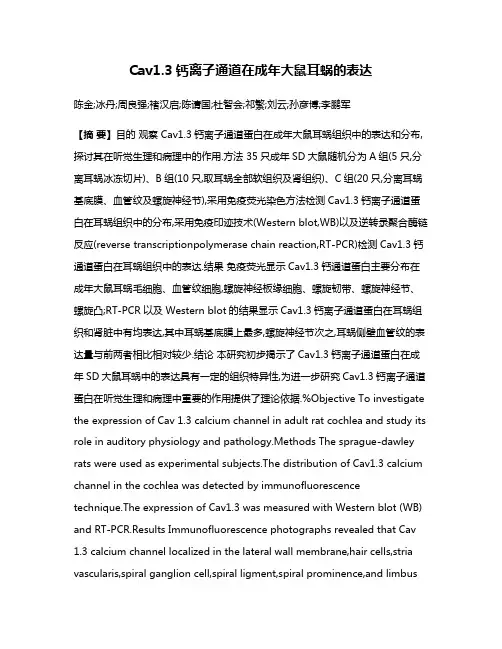
Cav1.3钙离子通道在成年大鼠耳蜗的表达陈金;冰丹;周良强;褚汉启;陈请国;杜智会;祁繁;刘云;孙彦博;李鹏军【摘要】目的观察Cav1.3钙离子通道蛋白在成年大鼠耳蜗组织中的表达和分布,探讨其在听觉生理和病理中的作用.方法 35只成年SD大鼠随机分为A组(5只,分离耳蜗冰冻切片)、B组(10只,取耳蜗全部软组织及肾组织)、C组(20只,分离耳蜗基底膜、血管纹及螺旋神经节),采用免疫荧光染色方法检测Cav1.3钙离子通道蛋白在耳蜗组织中的分布,采用免疫印迹技术(Western blot,WB)以及逆转录聚合酶链反应(reverse transcriptionpolymerase chain reaction,RT-PCR)检测Cav1.3钙通道蛋白在耳蜗组织中的表达.结果免疫荧光显示Cav1.3钙通道蛋白主要分布在成年大鼠耳蜗毛细胞、血管纹细胞,螺旋神经板缘细胞、螺旋韧带、螺旋神经节、螺旋凸;RT-PCR以及Western blot的结果显示Cav1.3钙离子通道蛋白在耳蜗组织和肾脏中有均表达,其中耳蜗基底膜上最多,螺旋神经节次之,耳蜗侧壁血管纹的表达量与前两者相比相对较少.结论本研究初步揭示了Cav1.3钙离子通道蛋白在成年SD大鼠耳蜗中的表达具有一定的组织特异性,为进一步研究Cav1.3钙离子通道蛋白在听觉生理和病理中重要的作用提供了理论依据.%Objective To investigate the expression of Cav 1.3 calcium channel in adult rat cochlea and study its role in auditory physiology and pathology.Methods The sprague-dawley rats were used as experimental subjects.The distribution of Cav1.3 calcium channel in the cochlea was detected by immunofluorescence technique.The expression of Cav1.3 was measured with Western blot (WB) and RT-PCR.Results Immunofluorescence photographs revealed that Cav 1.3 calcium channel localized in the lateral wall membrane,hair cells,stria vascularis,spiral ganglion cell,spiral ligment,spiral prominence,and limbuslaminae spiralis.The results of WB and RT-PCR inform Cav1.3 calcium channel gene (CACNA1D) were measured in the cochlea and kidney.The expression of Cav1.3was mainly in the basilar membrane.Moderate expression was observed in the spiral ganglion and striavascularis.Conclusion The preliminary study revealed the distribution of Cav 1.3 calcium channel gene(CACNA1D)in adult rat cochle possesses tissue specificity,providing a theoretical basis for further research in auditory physiology and pathology.【期刊名称】《听力学及言语疾病杂志》【年(卷),期】2017(025)006【总页数】4页(P630-633)【关键词】耳蜗;Cav1.3钙离子通道;大鼠【作者】陈金;冰丹;周良强;褚汉启;陈请国;杜智会;祁繁;刘云;孙彦博;李鹏军【作者单位】华中科技大学同济医学院附属同济医院耳鼻咽喉头颈外科武汉430030;华中科技大学同济医学院附属同济医院耳鼻咽喉头颈外科武汉430030;华中科技大学同济医学院附属同济医院耳鼻咽喉头颈外科武汉430030;华中科技大学同济医学院附属同济医院耳鼻咽喉头颈外科武汉430030;华中科技大学同济医学院附属同济医院耳鼻咽喉头颈外科武汉430030;华中科技大学同济医学院附属同济医院耳鼻咽喉头颈外科武汉430030;华中科技大学同济医学院附属同济医院耳鼻咽喉头颈外科武汉430030;华中科技大学同济医学院附属同济医院耳鼻咽喉头颈外科武汉430030;华中科技大学同济医学院附属同济医院耳鼻咽喉头颈外科武汉430030;华中科技大学同济医学院附属同济医院耳鼻咽喉头颈外科武汉430030【正文语种】中文【中图分类】R339.16Cav1.3钙离子通道蛋白是维持细胞内Ca2+浓度平衡的重要蛋白之一,它的主要作用是控制胞内Ca2+内流和细胞膜的去极化,从而维持内耳细胞内Ca2+稳态以及神经递质的释放,保证神经冲动的传导及内耳正常生理功能的发挥。
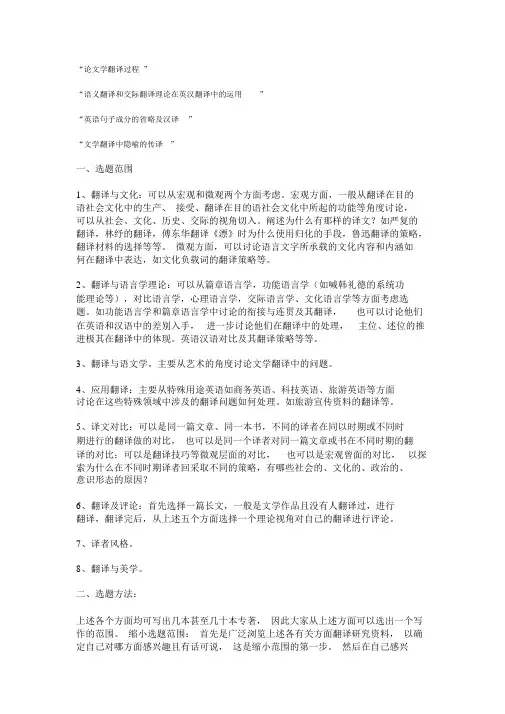
“论文学翻译过程”“语义翻译和交际翻译理论在英汉翻译中的运用”“英语句子成分的省略及汉译”“文学翻译中隐喻的传译”一、选题范围1、翻译与文化:可以从宏观和微观两个方面考虑。
宏观方面,一般从翻译在目的语社会文化中的生产、接受、翻译在目的语社会文化中所起的功能等角度讨论,可以从社会、文化、历史、交际的视角切入。
阐述为什么有那样的译文?如严复的翻译,林纾的翻译,傅东华翻译《漂》时为什么使用归化的手段,鲁迅翻译的策略,翻译材料的选择等等。
微观方面,可以讨论语言文字所承载的文化内容和内涵如何在翻译中表达,如文化负载词的翻译策略等。
2、翻译与语言学理论:可以从篇章语言学,功能语言学(如喊韩礼德的系统功能理论等),对比语言学,心理语言学,交际语言学、文化语言学等方面考虑选题。
如功能语言学和篇章语言学中讨论的衔接与连贯及其翻译,也可以讨论他们在英语和汉语中的差别入手,进一步讨论他们在翻译中的处理,主位、述位的推进极其在翻译中的体现。
英语汉语对比及其翻译策略等等。
3、翻译与语文学。
主要从艺术的角度讨论文学翻译中的问题。
4、应用翻译:主要从特殊用途英语如商务英语、科技英语、旅游英语等方面讨论在这些特殊领域中涉及的翻译问题如何处理。
如旅游宣传资料的翻译等。
5、译文对比:可以是同一篇文章、同一本书,不同的译者在同以时期或不同时期进行的翻译做的对比,也可以是同一个译者对同一篇文章或书在不同时期的翻译的对比;可以是翻译技巧等微观层面的对比,也可以是宏观曾面的对比,以探索为什么在不同时期译者回采取不同的策略,有哪些社会的、文化的、政治的、意识形态的原因?6、翻译及评论:首先选择一篇长文,一般是文学作品且没有人翻译过,进行翻译,翻译完后,从上述五个方面选择一个理论视角对自己的翻译进行评论。
7、译者风格。
8、翻译与美学。
二、选题方法:上述各个方面均可写出几本甚至几十本专著,因此大家从上述方面可以选出一个写作的范围。
缩小选题范围:首先是广泛浏览上述各有关方面翻译研究资料,以确定自己对哪方面感兴趣且有话可说,这是缩小范围的第一步。
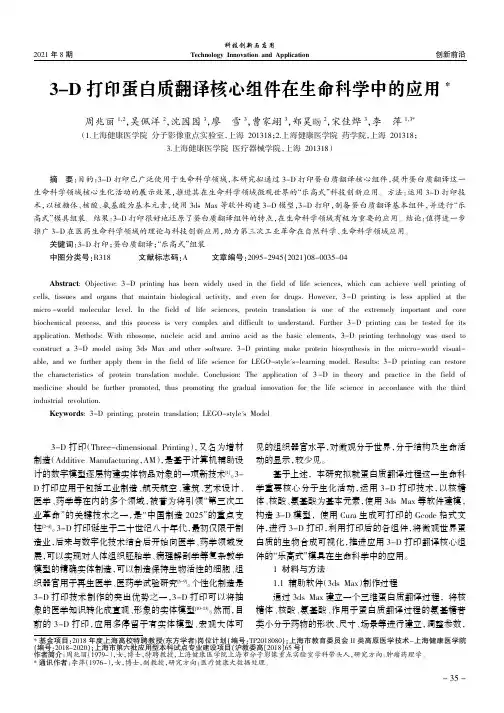
3-D打印蛋白质翻译核心组件在生命科学中的应用*周兆丽1,2,吴佩洋2,沈园园3,廖雪3,曹家翊3,郑昊旸2,宋佳烨3,李萍1,3*(1.上海健康医学院分子影像重点实验室,上海201318;2.上海健康医学院药学院,上海201318;3.上海健康医学院医疗器械学院,上海201318)3-D打印(Three-dimensional Printing),又名为增材制造(Additive Manufacturing,AM),是基于计算机辅助设计的数字模型逐层构建实体物品对象的一项新技术[1]。
3-D打印应用于包括工业制造、航天航空、建筑、艺术设计、医学、药学等在内的多个领域,被誉为将引领“第三次工业革命”的关键技术之一,是“中国制造2025”的重点支柱[2-4]。
3-D打印诞生于二十世纪八十年代,最初仅限于制造业,后来与数字化技术结合后开始向医学、药学领域发展,可以实现对人体组织胚胎学、病理解剖学等复杂教学模型的精确实体制造,可以制造保持生物活性的细胞、组织器官用于再生医学、医药学试验研究[5-9]。
个性化制造是3-D打印技术制作的突出优势之一,3-D打印可以将抽象的医学知识转化成直观、形象的实体模型[10-13]。
然而,目前的3-D打印,应用多停留于有实体模型、宏观大体可见的组织器官水平,对微观分子世界,分子结构及生命活动的显示,较少见。
基于上述,本研究拟就蛋白质翻译过程这一生命科学重要核心分子生化活动,运用3-D打印技术,以核糖体、核酸、氨基酸为基本元素,使用3ds Max等软件建模,构造3-D模型,使用Cura生成可打印的Gcode格式文件,进行3-D打印,利用打印后的各组件,将微观世界蛋白质的生物合成可视化,推进应用3-D打印翻译核心组件的“乐高式”模具在生命科学中的应用。
1材料与方法1.1辅助软件(3ds Max)制作过程通过3ds Max建立一个三维蛋白质翻译过程,将核糖体、核酸、氨基酸、作用于蛋白质翻译过程的氨基糖苷类小分子药物的形状、尺寸、场景等进行建立,调整参数,摘要:目的:3-D打印已广泛使用于生命科学领域,本研究拟通过3-D打印蛋白质翻译核心组件,提升蛋白质翻译这一生命科学领域核心生化活动的展示效果,推进其在生命科学领域微观世界的“乐高式”科技创新应用。
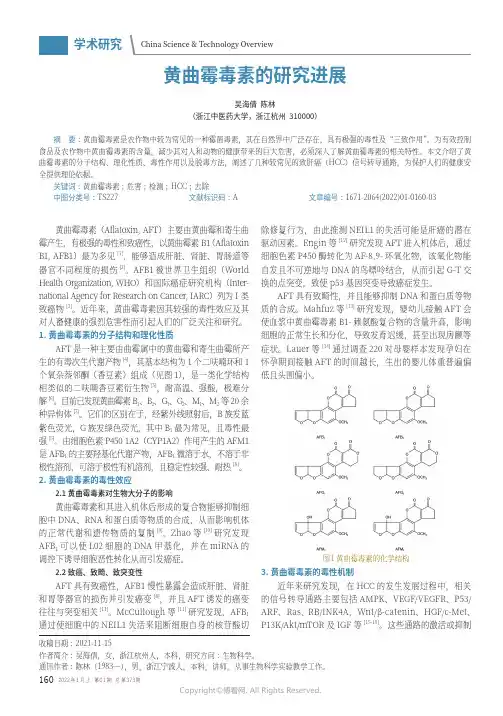
1602022年1月上 第01期 总第373期学术研究China Science & Technology Overview黄曲霉毒素(Afl atoxin, AFT)主要由黄曲霉和寄生曲霉产生,有极强的毒性和致癌性,以黄曲霉素B1(Afl atoxin B1, AFB1)最为多见[1],能够造成肝脏、肾脏、胃肠道等器官不同程度的损伤[2]。
AFB1被世界卫生组织(WorldHealth Organization, WHO)和国际癌症研究机构(Inter-national Agency for Research on Cancer , IARC)列为Ⅰ类致癌物[3]。
近年来,黄曲霉毒素因其较强的毒性效应及其对人畜健康的强烈危害性而引起人们的广泛关注和研究。
1.黄曲霉毒素的分子结构和理化性质AFT 是一种主要由曲霉属中的黄曲霉和寄生曲霉所产生的有毒次生代谢产物[4],其基本结构为1个二呋喃环和1个氧杂萘邻酮(香豆素)组成(见图1),是一类化学结构相类似的二呋喃香豆素衍生物[5],耐高温、强酸,极难分解[6]。
目前已发现黄曲霉素B 1、B 2、G 1、G 2、M 1、M 2等20余种异构体[7]。
它们的区别在于,经紫外线照射后,B 族发蓝紫色荧光,G 族发绿色荧光,其中B 1最为常见,且毒性最强[5]。
由细胞色素P450 1A2(CYP1A2)作用产生的AFM1是AFB 1的主要羟基化代谢产物,AFB 1微溶于水,不溶于非极性溶剂,可溶于极性有机溶剂,且稳定性较强、耐热[8]。
2.黄曲霉毒素的毒性效应2.1 黄曲霉毒素对生物大分子的影响黄曲霉毒素和其进入机体后形成的复合物能够抑制细胞中DNA、RNA 和蛋白质等物质的合成,从而影响机体的正常代谢和遗传物质的复制[9]。
Zhao 等[10]研究发现AFB 1可以使L02细胞的DNA 甲基化,并在miRNA 的调控下诱导细胞恶性转化从而引发癌症。
2.2 致癌、致畸、致突变性AFT 具有致癌性,AFB1慢性暴露会造成肝脏、肾脏和胃等器官的损伤并引发癌变[8],并且AFT 诱发的癌变往往与突变相关[11]。
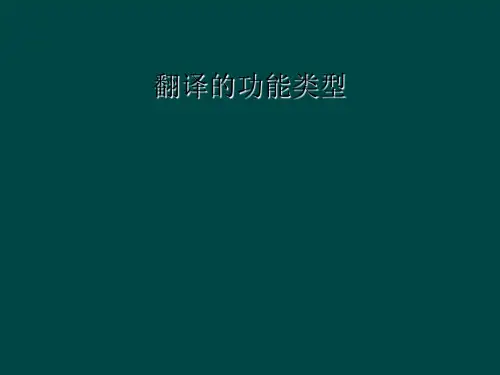
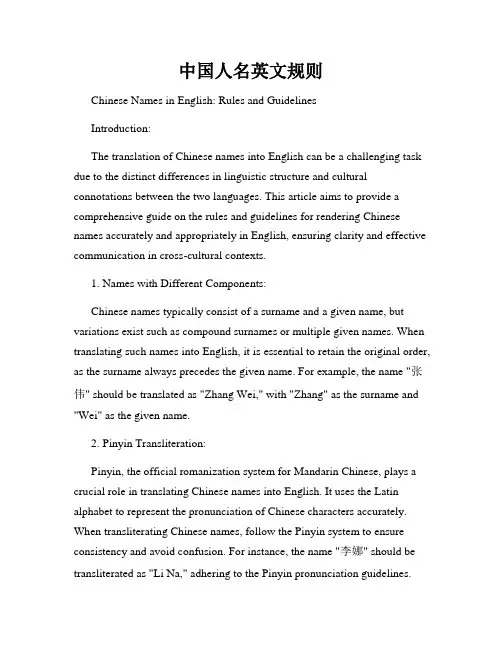
中国人名英文规则Chinese Names in English: Rules and GuidelinesIntroduction:The translation of Chinese names into English can be a challenging task due to the distinct differences in linguistic structure and cultural connotations between the two languages. This article aims to provide a comprehensive guide on the rules and guidelines for rendering Chinese names accurately and appropriately in English, ensuring clarity and effective communication in cross-cultural contexts.1. Names with Different Components:Chinese names typically consist of a surname and a given name, but variations exist such as compound surnames or multiple given names. When translating such names into English, it is essential to retain the original order, as the surname always precedes the given name. For example, the name "张伟" should be translated as "Zhang Wei," with "Zhang" as the surname and "Wei" as the given name.2. Pinyin Transliteration:Pinyin, the official romanization system for Mandarin Chinese, plays a crucial role in translating Chinese names into English. It uses the Latin alphabet to represent the pronunciation of Chinese characters accurately. When transliterating Chinese names, follow the Pinyin system to ensure consistency and avoid confusion. For instance, the name "李娜" should be transliterated as "Li Na," adhering to the Pinyin pronunciation guidelines.3. Surname Abbreviations:In certain cases, Chinese individuals may adopt an abbreviated version of their surname when introducing themselves in English-speaking contexts. This practice helps facilitate communication and addresses the challenges of pronunciation and recognition for non-Chinese speakers. For example, the surname "王" can be abbreviated to "Wang" instead of the full transliteration "Wáng," providing ease of use while retaining cultural identity.4. English Equivalent or Meaningful Translation:When translating Chinese names, it is common to search for an English equivalent that phonetically approximates the original pronunciation. However, if an equivalent is not readily available, a translation that captures the meaning or characteristics of the Chinese name can be used. This approach ensures that the English name reflects the essence of the original name. For instance, the name "贝克汉姆" can be translated as "Beckham," as it conveys the similar sound and cultural appeal associated with the renowned footballer.5. Personal Preferences and Cultural Sensitivity:Respecting an individual's personal preference for the translation or pronunciation of their name is crucial. Some individuals may choose an alternative name, while others may prefer to keep their original Chinese name intact. It is essential to honor and accommodate these preferences, as they reflect personal identity and cultural heritage.6. Common Mistakes to Avoid:When translating Chinese names into English, certain common mistakes should be avoided. Firstly, using literal translations that maintain the structure of Chinese names can result in awkward or confusing English names. Secondly, excessive modification or substitution of Chinese characters can lead to inaccurate or misleading renditions. Lastly, it is advisable to avoid overly generic English names, as they may diminish cultural distinctiveness.Conclusion:Translating Chinese names into English requires careful consideration of linguistic, cultural, and personal factors. Adhering to the rules and guidelines outlined in this article ensures accurate and appropriate representations of Chinese names in English, fostering effective cross-cultural communication. By respecting individuals' preferences and promoting cultural sensitivity, we can bridge linguistic and cultural gaps while maintaining the integrity of Chinese names in English contexts.。
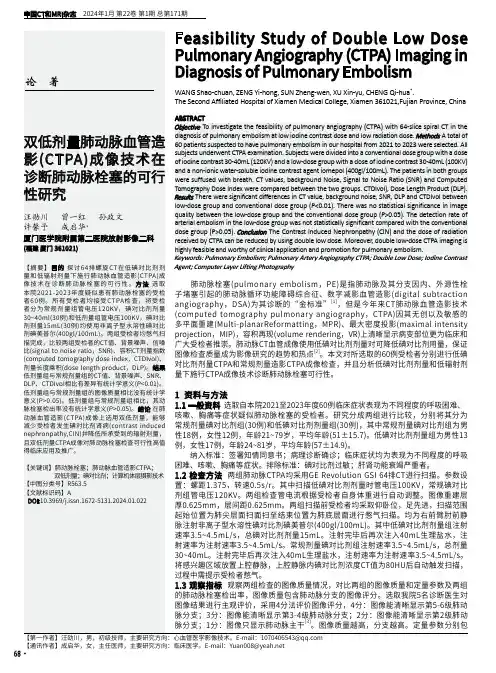
68·中国CT和MRI杂志 2024年1月 第22卷 第1期 总第171期【通讯作者】成启华,女,主任医师,主要研究方向:临床医学。
E-mail:****************FeasibilityCHINESE JOURNAL OF CT AND MRI, JAN. 2024, Vol.22, No.1 Total No.171含观察两组图像的CT值、信噪比(signal to noise ratio,SNR)、剂量长度乘积(dose length product,DLP)、容积CT剂量指数(computed tomography dose index,CTDIvoI)。
CT值测量的测试点选择在肺动脉主干及左右肺动脉分支取三个敏感区的平均CT 值,肺动脉干层面的胸前空气区左中右三个区域取三个敏感区,大小范围15mm,测量标准差的平均值作为背景噪声。
SNR=CT 值/背景噪声[4]。
DLP和CTDIvoI均由CT机自动测量。
图1 低碘对比剂剂量受检者VR图像;图2 低碘对比剂剂量受检者MIP显示分支;121.4 数据统计 数据采用SPSS 22.0统计学软件分析处理,计数资料采用率(%)表示,行χ2检验,计量资料用(χ-±s)表示,行t 检验,P<0.05为差异有统计学意义。
2 结 果2.1 两种检查的图像质量对比 两种检查方式的图像质量对比差异无统计学意义(P>0.05),见表1。
2.2 两种检查方式的定量参数对比 低剂量组与常规剂量组的CT 值、背景噪声、SNR、DLP、CTDIvoI相比差异具有统计学意义(P<0.01),见表2。
2.3 两种检查对于肺动脉栓塞的检出率 低剂量组30例肺动脉栓塞检出率为93%,常规剂量组30例肺动脉栓塞检出率为90%,低剂量组与常规剂量组肺动脉栓塞检出率对比差异无统计学意义(P>0.05),见表3。
3 讨 论 肺动脉栓塞是一种危机重症,受检者的死亡率非常高,对受检者的生命健康及生命安全有着非常严重的威胁[5]。
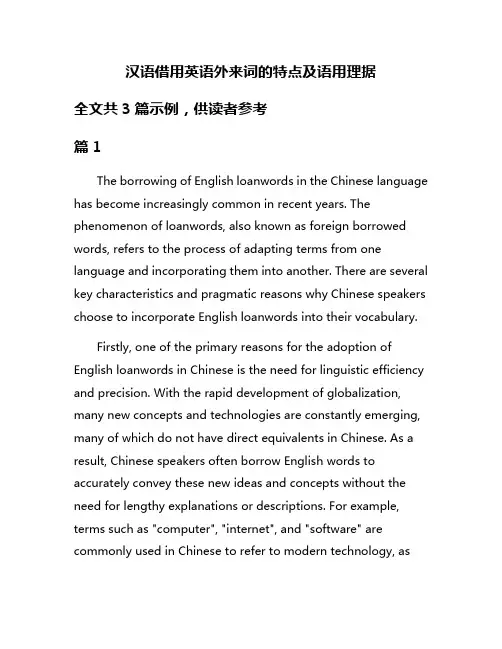
汉语借用英语外来词的特点及语用理据全文共3篇示例,供读者参考篇1The borrowing of English loanwords in the Chinese language has become increasingly common in recent years. The phenomenon of loanwords, also known as foreign borrowed words, refers to the process of adapting terms from one language and incorporating them into another. There are several key characteristics and pragmatic reasons why Chinese speakers choose to incorporate English loanwords into their vocabulary.Firstly, one of the primary reasons for the adoption of English loanwords in Chinese is the need for linguistic efficiency and precision. With the rapid development of globalization, many new concepts and technologies are constantly emerging, many of which do not have direct equivalents in Chinese. As a result, Chinese speakers often borrow English words to accurately convey these new ideas and concepts without the need for lengthy explanations or descriptions. For example, terms such as "computer", "internet", and "software" are commonly used in Chinese to refer to modern technology, asthere are no direct translations that adequately capture the nuances of these terms.Furthermore, the use of English loanwords in Chinese can also be attributed to the influence of Western culture and media. With the widespread popularity of Western entertainment, such as movies, music, and fashion, Chinese speakers are exposed to a wide range of English vocabulary on a daily basis. As a result, many English loanwords have become integrated into Chinese language usage, particularly among younger generations who are more likely to embrace Western culture.In addition, the adoption of English loanwords in Chinese can also serve as a form of social prestige or status symbol. By using English loanwords in their speech or writing, Chinese speakers may seek to demonstrate their education, sophistication, or international outlook. This is particularly evident in professional settings, where the use of English loanwords can convey professionalism and expertise in a particular field. For example, in the business world, terms such as "marketing", "strategy", and "management" are commonly used in Chinese to discuss business practices and concepts, as they are seen as more sophisticated and professional than their Chinese counterparts.Despite the benefits of incorporating English loanwords into Chinese, there are also potential drawbacks to consider. The overuse of English loanwords can lead to language pollution and the erosion of traditional Chinese vocabulary. In addition, the improper use or misinterpretation of English loanwords can result in misunderstanding or miscommunication among Chinese speakers.In conclusion, the borrowing of English loanwords in Chinese is a complex and multifaceted phenomenon that is influenced by a variety of linguistic, cultural, and social factors. While the use of English loanwords can facilitate communication and enhance linguistic diversity, it is important for Chinese speakers to use these loanwords judiciously and in appropriate contexts to avoid language degradation and confusion.篇2The borrowing of English loanwords into Chinese has become increasingly common in recent years, reflecting the growing influence of English in the global arena. This trend has not only enriched the Chinese language, but also brought about changes in the way Chinese speakers communicate. In this article, we will explore the characteristics of Chinese loanwords from English and their pragmatic functions.One of the key features of Chinese loanwords from English is their adaptability to the Chinese language system. While loanwords from other languages may undergo extensive alterations to fit into Chinese phonology and morphology, English loanwords often retain their original pronunciation and spelling. This is due to the relatively high degree of similarity between English and Mandarin phonetic systems, as well as the widespread use of the Latin alphabet in Chinese transliteration.Another characteristic of English loanwords in Chinese is their selective adoption based on semantic gaps in the Chinese lexicon. Many English loanwords are introduced into Chinese to express concepts or referents that do not have exact equivalents in Chinese. For example, the word "wifi" is borrowed into Chinese as "无线网络" (wúxiàn wǎngluò) to denote wireless intern et, a concept that did not exist in traditional Chinese culture. By borrowing English loanwords, Chinese speakers are able to fill lexical gaps and communicate more efficiently in a globalized context.In addition to semantic considerations, the pragmatic functions of English loanwords in Chinese are also worth noting. English loanwords are often used to convey a sense of modernity, technology, or sophistication in Chinese discourse. For example,the use of English loanwords such as "cool" or "fashion" in Chinese may signal a speaker's desire to appear trendy or cosmopolitan. In this way, English loanwords serve as markers of social identity and cultural prestige in contemporary Chinese society.Furthermore, English loanwords in Chinese can also facilitate communication in specific domains or discourse communities. For example, in the fields of science, technology, and business, English loanwords are commonly used to refer to specialized terms and concepts that are universally recognized. By incorporating English loanwords into their discourse, Chinese speakers can enhance clarity and precision in communication with international colleagues and audiences.In conclusion, the borrowing of English loanwords into Chinese reflects the dynamic nature of language contact and adaptation in a globalized world. The characteristics of Chinese loanwords from English, such as adaptability, selective adoption, and pragmatic functions, demonstrate the complex interplay between linguistic systems and social contexts. As English continues to exert influence on Chinese language and culture, the phenomenon of loanword borrowing is likely to continueevolving and shaping the linguistic landscape of contemporary China.篇3With the increasing globalization and influence of Western culture, the phenomenon of borrowing English loanwords into Chinese has become more and more common in recent years. This practice of incorporating foreign words into the Chinese language is known as "汉语借用英语外来词" (Hànyǔ jièyòngYīngyǔ wàiláicí).There are several distinctive characteristics of the borrowing of English loanwords in Chinese. Firstly, the loanwords are usually adapted to fit the phonetic and syllabic structure of the Chinese language. This often involves transliterating the English word into Chinese characters that approximate its pronunciation. For example, the English word "coffee" is borrowed into Chinese as "咖啡" (kāfēi), which closely mirrors the sound of the original word.Secondly, loanwords in Chinese often undergo semantic shifts or extensions in meaning. This can be due to cultural differences between English-speaking countries and China, as well as the need to express new concepts or ideas that do nothave existing equivalents in Chinese. For example, the English word "cool" has been borrowed into Chinese to mean "fashionable" or "stylish," rather than its original literal meaning of low temperature.Additionally, the borrowing of English loanwords in Chinese is often influenced by social factors and trends. For instance, certain industries or professions may adopt English terms to give an air of modernity or sophistication. This is particularly common in fields such as technology, business, and popular culture, where English is often seen as a symbol of innovation and progress.From a linguistic perspective, the incorporation of English loanwords into Chinese can be seen as a form of code-switching or bilingualism. It allows Chinese speakers to draw on the resources of both languages to express themselves more effectively and adapt to the changing linguistic landscape. It also reflects the dynamic nature of language and the constant evolution of vocabulary to meet the needs of contemporary society.In conclusion, the borrowing of English loanwords in Chinese reflects the ongoing interaction between different cultures and languages in our increasingly interconnected world. By analyzingthe characteristics and language usage of these loanwords, we can gain insights into the ways in which language shapes and reflects our social reality.。
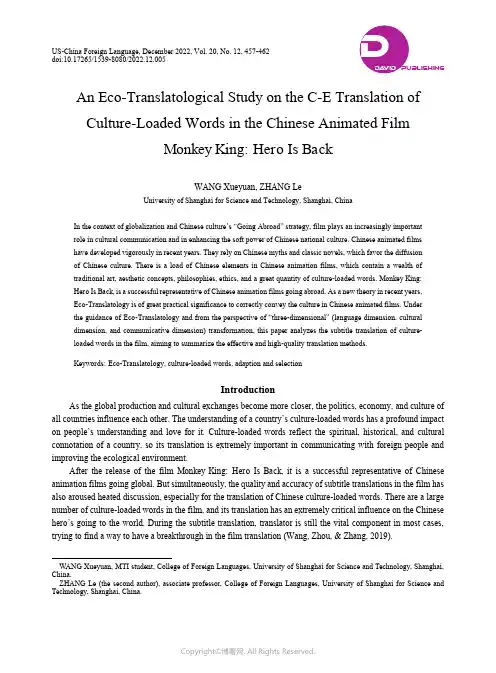
US-China Foreign Language, December 2022, Vol. 20, No. 12, 457-462doi:10.17265/1539-8080/2022.12.005 An Eco-Translatological Study on the C-E Translation ofCulture-Loaded Words in the Chinese Animated FilmMonkey King: Hero Is BackWANG Xueyuan, ZHANG LeUniversity of Shanghai for Science and Technology, Shanghai, ChinaIn the context of globalization and Chinese culture’s “Going Abroad” strategy, film plays an increasingly importantrole in cultural communication and in enhancing the soft power of Chinese national culture. Chinese animated filmshave developed vigorously in recent years. They rely on Chinese myths and classic novels, which favor the diffusionof Chinese culture. There is a load of Chinese elements in Chinese animation films, which contain a wealth oftraditional art, aesthetic concepts, philosophies, ethics, and a great quantity of culture-loaded words. Monkey King:Hero Is Back , is a successful representative of Chinese animation films going abroad. As a new theory in recent years,Eco-Translatology is of great practical significance to correctly convey the culture in Chinese animated films. Underthe guidance of Eco-Translatology and from the perspective of “three -dimensional” (language dimension, culturaldimension, and communicative dimension) transformation, this paper analyzes the subtitle translation of culture-loaded words in the film, aiming to summarize the effective and high-quality translation methods.Keywords: Eco-Translatology, culture-loaded words, adaption and selectionIntroductionAs the global production and cultural exchanges become more closer, the politics, economy, and culture ofall countries influence each other. The understanding of a country’s culture -loaded words has a profound impact on people’s understanding and love for it. Culture -loaded words reflect the spiritual, historical, and cultural connotation of a country, so its translation is extremely important in communicating with foreign people and improving the ecological environment.After the release of the film Monkey King: Hero Is Back , it is a successful representative of Chineseanimation films going global. But simultaneously, the quality and accuracy of subtitle translations in the film has also aroused heated discussion, especially for the translation of Chinese culture-loaded words. There are a large number of culture-loaded words in the film, and its translation has an extremely critical influence on the Chinese hero’s going to the world. During the subtitle translation, translator is still the vital component in most cases, trying to find a way to have a breakthrough in the film translation (Wang, Zhou, & Zhang, 2019). WANG Xueyuan, MTI student, College of Foreign Languages, University of Shanghai for Science and Technology, Shanghai, China.ZHANG Le (the second author), associate professor, College of Foreign Languages, University of Shanghai for Science andTechnology, Shanghai, China.DA VID PUBLISHINGDAN ECO-TRANSLATOLOGICAL STUDY ON THE C-E TRANSLATION458In recent years, Chinese animated films have also allowed foreigners to learn about Chinese spirit and culture, such as Kung Fu Panda, Monkey King, Nezha, and Mulan. This kind of Chinese film with cultural connotation allows more foreigners to understand Chinese culture objectively. The translation of subtitles is a fundamental means for the dissemination of film culture and Chinese culture, and its translation quality affects the acceptance and satisfaction of foreigners for it. For any type of translation, how to convert the characteristic cultural content of the language is a difficult problem that the translator must face (K. F. Wang & Y. C. Wang, 2016), especially for the movie Hero Is Back. It is adapted from the Chinese traditional mythology novel Journey to the West, which contains a wealth of traditional culture and culture-loaded words; its subtitle translation is of great research value under the background of Chinese culture going out. Translating words containing Chinese traditional culture from the perspective of ecological translation will help traditional culture grow abroad, and allow more foreigners to understand Chinese culture, thereby achieving the goal of improving the weak status of Chinese in the world language system.Literature ReviewPrevious Researches on the Translation of Culture-Loaded WordsCulture-loaded words reflect the characteristics of the national culture, including unique words, phrases, and idioms. In the long historical development process, it reflects the characteristics of the national culture and is significantly different from other national cultures (Liao, 2000, p. 232). The choice of translation strategies and methods for Chinese culture-loaded words should consider the principle of equality in intercultural communication and serve the Chinese culture to go global (Zheng, 2016). Communication based on equality favors the objectivity and precision of cultural dissemination, which enhances the soft power of Chinese culture. Therefore, in the context of globalization, in order to obtain language and emotion equality in the communication process and information exchange, the translator has to handled Chinese culture-loaded words well, which helps foreign audiences understand and love Chinese culture.The Theoretical Researches on Eco-Translatology TheoryConforming to nature has been the advocation of Chinese traditional culture for thousands of years. In the new century, since the harm caused by environmental degradation is getting more and more serious, people around the world put increasing attention towards the environmental protection. Therefore, the term “ecology” is currently a hot topic.In fact, similar theories were proposed before the Eco-Translatology theory proposed. As early as 1987, Yev Warren (1989) used Darwin’s natural selection-adaptation theory to introduce biological sciences into linguistics, and set up a new theoretical framework for language use research. Eugene Nida (1993) stated that in order to adapt to different languages and cultures, to meet the “tastes” of different readers, translators need to make corresponding choices and processing on the translation.All related translation studies in the past laid a basis for the Eco-Translatology theory. Hu Gengshen (2008) formally proposed the term “ecological translation studies” based on his monograph “the survival and choice of the fittest in translation”. Hu Gengsheng combines the philosophical concept of “ecological existence” with the ancient Chinese philosophy, which provides a new perspective for the translation of culture-loaded words. When porting culture-loaded words from one language to another, we need to examine the ecological environment of the target language, which is the same as moving plants and animals to a completely unknownAN ECO-TRANSLATOLOGICAL STUDY ON THE C-E TRANSLATION459place. Consequently, ecological translation is more conducive to Chinese culture going out, and it is more conducive to the survival of Chinese culture’s endless text transplantation and the “endlessness” of text ual life (Hu, 2020).The core concept is “choice and adaptation”. They must be like the adaptation and growth of an individual or a nation. There is only adaptation to survive through changes in the new environment (Warren, 1989, p. 6). From language to culture, the core connotation of text transplantation is the adaptation and evolution. As a life form for the survival of the fittest, being born, derive, generate, regenerate, and survive are the key points of Eco-Translatology (Hu, 2019). The “translator-centered” theory is its core and multidimensional transformation is its specific translation method (Hu, 2008). The essence of ecological translation is adaptation and choice by three-dimensional transformations: language dimension, cultural dimension, and communicative dimension.Eco-Translatology proposes translation as ecological balance from the macro, middle, and micro perspectives, through the translation system, translation theory, and translation studies of translation behavior (Hu, 2019). Under the guidance of the new ecological translation concept, it promotes and maintains the coordination and balance between translation ecology and ecological translation.Translation of Culture-Loaded Words Under the Three-Dimensional Transformations The ecological environment of the target language reader, as well as its natural geographical environment, social customs, cultural context, and political environment all directly or indirectly affect the translation process. According to Hu Gengshen (2013), Eco-Translatology is a “study of ecological translation methods” or “study from an ecological perspective” translation. Three-dimensional transformations are its specific translation method. The method of Eco-Translatology focuses on the adaptive selection and transformation in language, cultural, and communicative dimensions, so that the translation can survive and regenerate in the ecological environment of the target language.Adaption and Selection in the Language DimensionLanguage is the pivotal carrier of culture and information, through which we can achieve communicative and textual purpose. It can reflect the social life, customs, and historical trajectories of a country or nation, and thus permeate all aspects of people’s lives. The movie Hero Is Back has a great deal of vocabulary, syntax, and style with Chinese characteristics. This part uses examples to analyze the translation of culture-loaded words in terms of idioms, colloquialisms, and allusions.According to the Eco-Translatology theory, during translation activities, the translator will make adaptive choices of language dimensions from multiple aspects and levels. The choice of adaptation of the language dimension is mainly word level conversion, but it is by no means a rigid literal translation of word-to-word. It requires translators to interpret the meaning of the word based on his or her own understanding, so that foreign audiences can better understand the film.Example 1: 他法力高强,神通广大。


中医治疗持续性姿势-感知性头晕(PPPD)的研究进展发布时间:2022-11-14T07:13:57.170Z 来源:《医师在线》2022年6月12期作者:刘芳唐婷谢慧通讯作者[导读]中医治疗持续性姿势-感知性头晕(PPPD)的研究进展刘芳唐婷谢慧通讯作者(成都中医药大学附属医院;四川成都610036)【摘要】持续性姿势-感知性头晕是特指客观检查没有明显异常而表现为慢性头晕的一类疾病。
其核心症状主要是头晕、不稳、非旋转性眩晕,患者常表现为其中的一个或多个症状,持续时间常超过3个月,在直立、主动或被动运动、移动视觉刺激或复杂视觉环境中会加重。
目前主要的中医治疗方法包括:中药治疗、针灸疗法、针药结合等治疗方法,本文检索近20年中医治疗持续性姿势-感知性头晕的临床文献,进行整理、归纳、分析,旨在为今后的临床治疗提供思路。
【关键词】中医;治疗;持续性姿势-感知性头晕;综述持续性姿势-感知性头晕(persistent postural-perceptual dizziness,PPPD)是一个新的医学术语,随着其近几年在国内的普及,临床医生对功能性头晕的诊断率明显提高[1],大样本病例的持续深入研究使得PPPD的病理生理机制、诊断标准、分类、鉴别诊断、治疗方案越发明晰。
Bárány学会前庭疾病分类委员会共识[2]中指出目前尚缺乏针对PPPD的流行病学研究,但可根据急性前庭综合征后恐惧性姿势性眩晕(PPV)、慢性主观性头晕(CSD)、视觉眩晕综合征(VV)和其他慢性眩晕患者的研究进行估计其发病率和患病率[3][4][5][6][7][8]。
Bittar、Yan、Staab JP等[8][9][10]的研究表明PPPD患者年龄多在40-60岁,女性多于男性;范围从青春期到成年晚期。
1持续性姿势-感知性头晕(PPPD)的中医认识中医将持续性姿势-感知性头晕归属于眩晕范畴[11][12],《内经》对眩晕涉及脏腑、病性归属均有记述。
参考文献[1]国家癌症中心,国家肿瘤质控中心胃癌质控专家委员会.中国胃癌规范诊疗质量控制指标(2022版)[J].中华肿瘤杂志,2022,44(10):997-1002.[2]SiegelRL,MillerKD,WagleNS,etal.Cancerstatistics,2023[J].CACancerJClin,2023,73(1):17-48.[3]BrayF,FerlayJ,SoerjomataramI,etal.Globalcancerstatistics2018:GLOBOCANestimatesofincidenceandmortalityworldwidefor36cancersin185countries[J].CACancerJClin,2018,68(6):394-424.[4]郑㊀琪,丁彩霞,李索妮,等.胃印戒细胞癌伴 冰冻腹 1例病例报道[J].消化肿瘤杂志(电子版),2022,14(3):360-363.[5]TanZ.Recentadvancesinthesurgicaltreatmentofadvancedgastriccancer:areview[J].MedSciMonit,2019,25:3537-3541.[6]RodríguezSalasN,Gonz lezPazC,RiveraT,etal.Colonicanasto⁃mosisandcolonicpolypmucosalmetastasisofsignetringcellgastricadenocarcinoma[J].ClinTranslOncol,2010,12(3):238-239.[7]OgiwaraH,KonnoH,KitayamaY,etal.Metastasesfromgastricade⁃nocarcinomapresentingasmultiplecolonicpolyps:reportofacase[J].SurgToday,1994,24(5):473-475.[8]厉㊀瑶,厉学民,王连云,等.胃癌卵巢转移23例临床分析[J].浙江医学,2018,40(11):1250-1251.[9]齐增平,李江花,左献军.希罗达治疗老年胃癌双侧肾上腺转移患者1例报告[J].中国民康医学,2016,28(14):80.[10]ChuaWJ,WanWK,YewTanDM.Ararecaseofduodenalpapillametastasisfromthegastroesophagealjunction[J].AmJGastroen⁃terol,2022,117(2):213.[11]MishimaM,SakuraiT,MiyamotoS.Intramucosalmetastasisofgas⁃triccancertotheduodenum[J].ClinGastroenterolHepatol,2019,17(13):A27.[12]丁苗苗,高㊀平,高亚杰,等.胃癌术后小肠转移1例[J].大连医科大学学报,2017,39(2):205-206.[13]任佳欣,程彩霞.胃癌子宫内膜转移1例报道[J].肿瘤学杂志,2022,28(8):703-704.[14]FléjouJF.WHOclassificationofdigestivetumors:thefourthedi⁃tion[J].AnnPathol,2011,31(5Suppl):S27-S31.[15]GoldsteinNS,LongA,KuanSF,etal.Colonsignetringcellade⁃nocarcinoma:immunohistochemicalcharacterizationandcomparisonwithgastricandtypicalcolonadenocarcinomas[J].ApplImmuno⁃histochemMolMorphol,2000,8(3):183-188.[收稿日期㊀2023-09-15][本文编辑㊀韦㊀颖]本文引用格式陈彩云,包㊀真,欧阳鹏,等.胃癌回肠转移一例[J].中国临床新医学,2024,17(3):338-340.㊀㊀[关键词]㊀胰腺肿瘤;㊀假乳头状瘤;㊀肝转移;㊀病例报道㊀㊀[中图分类号]㊀R735 9㊀[文献标识码]㊀B㊀[文章编号]㊀1674-3806(2024)03-0340-03㊀㊀doi:10.3969/j.issn.1674-3806.2024.03.191 病例介绍患者,女,44岁,因 发现腹部占位1周 于2020年4月20日入住宜昌市中心人民医院㊂体格检查:腹部平软,无压痛㊁反跳痛,未触及包块,肝脾未触及,Murphy征(-),肝区无叩击痛,无移动性浊音,肠鸣音正常㊂血常规㊁生化检查无明显异常,肿瘤标志物阴性㊂胰腺平扫增强CT检查(见图1):胰腺尾部见团块状混杂低密度影,大小约6 3cmˑ5 8cm,病灶密度不均,内见点状钙化,周围间隙稍模糊,增强扫描病灶强化程度低于正常胰腺强化程度,肝内见多发类圆形低密度影,边界欠清,增强扫描病灶环形强化,胆囊结节状高密度影,脾脏增大㊂胰腺动㊁静脉造影检查:胰腺病灶由脾动脉分支供血,脾脏静脉受侵,近中远段闭塞,周围多发侧支血管,胃壁静脉曲张,右侧见副肾动脉㊂影像学诊断考虑胰腺癌伴肝转移㊁胆囊结石㊁脾大㊂正电子发射断层扫描/计算机断层扫描(positronemissiontomography/computedtomography,PET/CT)提示胰腺尾部团块病灶,代谢异常增高,考虑肿瘤;肝脏多发低密度结节,代谢增高,考虑肝脏转移㊂患者于2020年4月22日在超声㊃143㊃㊀㊀中国临床新医学㊀2024年㊀3月㊀第17卷㊀第3期引导下行肝占位穿刺活检术,病理结果提示:镜下见肝细胞分化尚好,另见较多异型细胞呈腺样㊁实性巢状排列,周围间质细胞见黏液样变性,细胞内外可见嗜酸性小体,考虑为恶性肿瘤㊂肝脏穿刺物免疫组化结果(见图2):CK8/18(+),CK19(-),CK7(-),AFP(-),GS(+),Glypican⁃3(+),HSP70(弱+),CD10(+),Ki⁃67(约7%+),CgA(-),Syn(-),CD56(膜+),HCC(-),pgp9 5(-),CD34(血管+),Vimentin(+),PR(弱+),β⁃catenin(浆㊁核+),NSE(部分弱+),E⁃cad(-)㊂特殊染色结果:PAS(+),PAS+淀粉酶(+)㊂5月8日在全麻下行腹腔镜辅助中转开腹的胰体尾切除㊁脾脏切除㊁胆囊切除㊁肝脏多发肿瘤切除术,术后予以对症治疗㊂术后病理结果:(1)结合镜下形态及免疫表型,符合胰腺实性假乳头状瘤(solidpseudopapillaryneoplasmofthepancreas,SPN)伴出血,肿瘤大小约6 5cmˑ6 0cmˑ5 0cm㊂免疫组化结果(见图3)为CD10(+),CD56(+),CgA(-),CyclinD1(+),Galectin⁃3(散在+),NSE(部分+),Vimen⁃tin(+),PR(部分+),Ki⁃67(约5%+),Syn(散在+),β⁃cate⁃nin(+),PCK(AE1/AE3,散在+)㊂(2)送检(肝转移瘤)镜下可见实性假乳头状瘤图像,染色结果:PAS(+),PAS+淀粉酶(+)㊂(3)慢性胆囊炎伴胆石症㊂术后病理结果结合手术标本免疫组化结果,诊断为SPN伴肝转移㊂患者出院后2次来院行介入栓塞治疗㊂患者于当地医院定期复查,电话随访3年,未见复发及转移㊂本研究获宜昌市中心人民医院医学伦理委员会批准㊂ⓐ肝脏多发低密度影;ⓑ胰腺尾部可见团块状低密度影图1㊀胰腺影像学检查所见㊀ⓐHE染色(ˑ100);ⓑCD10染色(ˑ40);ⓒVimentin染色(ˑ40);ⓓβ⁃catenin染色(ˑ100)图2㊀肝脏穿刺物病理检查所见㊀ⓐHE染色(ˑ100);ⓑCD10染色(ˑ40);ⓒVimentin染色(ˑ40);ⓓβ⁃catenin染色(ˑ100)图3㊀术后胰腺肿物病理检查所见2㊀讨论2 1㊀SPN是罕见的胰腺低度恶性肿瘤㊂该肿瘤一般为较大且边界清楚的混合性实体瘤或囊性肿瘤,占外分泌型胰腺肿瘤的1% 2%,占胰腺囊性肿瘤的5%[1]㊂SPN可发生在胰腺任何部位,以体尾部较常见㊂有研究表明,性激素可能参与SPN的发病机制,孕酮可能是其致癌因子,因此SPN常见于年轻女性,男性和老年人的发病率较低[2⁃3]㊂转移性SPN少见,占SPN的5% 15%,肝脏转移的报道较常见,可能与胰腺静脉回流有关[4]㊂因胰腺是腹膜间位器官,当肿瘤向周围侵犯时,其邻近器官组织,如肝脏㊁十二指肠㊁腹膜及邻近血管等容易受累[5]㊂本例报道为44岁女性患者,其肿瘤发生在胰腺体尾部并肝脏多发转移㊂2 2㊀大多数SPN患者有上腹不适等非特异性症状,或有肿瘤逐渐增大产生的压迫症状,部分患者完全没有症状,仅通过影像学检查偶然发现肿瘤,几乎没有实验室特异性指标[6]㊂SPN在CT上通常表现为边界清楚的圆形或卵圆形低密度影,出血和囊变则表现为更低密度区,难以与其他胰腺肿瘤相鉴别,例如胰腺癌㊁胰腺浆液或黏液性囊腺瘤㊁囊腺癌㊁胰腺囊肿等[7]㊂本例患者急行腹部CT时发现大小约6 3cmˑ5 8cm的胰腺尾部占位性病变,脾脏血管受侵,考虑为胰腺癌,并且肝内占位图像与胰腺占位有相似表现,PET/CT提示胰腺尾部团块病灶及肝脏多发低密度结节代谢异常增高,初步诊断为胰腺癌伴肝脏转移,但仍需进一步病理检查明确诊断㊂2 3㊀SPN可采用超声内镜进行占位组织穿刺活检[8]㊂本例患者有肝脏转移灶,先进行肝脏占位组织活检,检查结果考虑为恶性肿瘤,遂行腹腔镜下胰腺体尾切除㊁脾脏切除㊁胆囊切除㊁肝脏多发肿瘤切除术㊂SPN通常为边界清楚的圆形或类圆形肿物,一般较㊃243㊃ChineseJournalofNewClinicalMedicine,March2024,Volume17,Number3㊀㊀大,有实性㊁囊性㊁出血和坏死等多样表现,以实性为主的SPN较少见[9]㊂本例患者胰腺肿物与周围组织分界较清,切面灰白,呈实性,部分区域出血㊁坏死;肝脏转移瘤直径为0 9 2 7cm,包膜完整,与周围组织分界较清,切面灰白,呈实性㊂SPN在镜下呈一种带有血管柄的假乳头和有出血的囊性成分的特征性结构,间质伴透明变㊁黏液变,其间有丰富的毛细血管,肿瘤细胞的细胞质嗜酸性,核圆而小,染色质细腻,常有核沟或凹陷,通常呈凹槽状[10]㊂本例患者送检标本镜下可见多异型细胞,周围间质细胞黏液样变性,细胞内外可见嗜酸性小体㊂除了镜下形态,还需要通过免疫组化来进一步明确诊断㊂不同肿瘤细胞表现出不同程度的异质性,在SPN中,β⁃catenin㊁Vimentin㊁α1⁃抗胰蛋白酶㊁神经元特异性烯醇化酶等通常呈强阳性染色,CD10以及孕激素受体大多呈阳性,角蛋白在大部分病例中有表达[11⁃12]㊂本例患者胰腺肿物及肝脏穿刺物免疫组化结果显示β⁃catenin㊁Vimentin㊁CD10等染色阳性,明确诊断为SPN伴肝脏转移㊂2 4㊀手术是SPN患者的首选治疗方案,具体手术方式取决于肿瘤的位置㊁大小以及其对周围组织侵犯㊁转移等情况㊂肿瘤若发生在胰头,一般行根治性胰十二指肠切除术;若发生在胰腺体尾部,一般行远端胰腺切除术㊂有研究提出SPN摘除术不仅能取得相似的手术效果,也不会增加复发风险,而且与传统术式相比,还有恢复更快㊁减少腺体分泌功能影响的优点[13⁃14]㊂由于SPN的罕见性和惰性,其肝转移的最佳治疗方案尚不明确㊂本例患者肿瘤发生在胰腺尾部及肝脏,首选行腹腔镜下胰体尾㊁肝脏多发转移瘤㊁脾切除术,由于患者脾脏动脉和静脉受侵犯,分离困难,最终行中转开腹术㊂与胰腺癌不同,大多数SPN伴肝脏转移的患者进行转移病灶手术切除后存活时间延长,预后良好[13,15]㊂对于不能切除或不能完全切除肝脏转移灶的患者,采用射频消融术㊁介入栓塞术㊁放疗或化疗等措施也能取得良好效果[6]㊂本例患者肝脏转移灶>5个,不适宜行肝脏转移瘤射频消融术,出院后患者2次来院行介入栓塞术治疗㊂在3年随访中,患者未见复发及转移㊂综上所述,SPN是一种罕见的低度恶性肿瘤,常见于年轻女性,罕见转移㊂实验室检查以及影像学检查往往难以确诊,SPN诊断标准主要依靠病理检查㊂SPN伴肝转移通常首选的治疗方式为手术切除原发肿瘤以及转移灶,针对不能手术切除的肝转移灶也可行射频消融术㊁介入栓塞术等综合治疗,一般预后良好㊂参考文献[1]ChenJ,ZongL,WangP,etal.Solidpseudopapillaryneoplasmsofthepancreas:clinicopathologicanalysisandapredictivemodel[J].ModPathol,2023,36(6):100141.[2]WuJ,MaoY,JiangY,etal.Sexdifferencesinsolidpseudopapil⁃laryneoplasmofthepancreas:apopulation⁃basedstudy[J].CancerMed,2020,9(16):6030-6041.[3]WeiG,LuoQ,FangJ,etal.Thesexfeaturesofpatientswithsolidpseudopapillaryneoplasmsofthepancreas:aretrospectivestudy[J].FrontOncol,2022,12:844182.[4]DhaliA,RayS,DasS,etal.Clinicalprofileandoutcomeofsolidpseudopapillaryneoplasmofthepancreas:aretrospectivestudyon28patients[J].IntJSurg,2022,104:106708.[5]SantosD,CalhauA,BacelarF,etal.Solidpseudopapillaryneoplasmofpancreaswithdistantmetastasisduringpregnancy:adiagnosticandtreatmentchallenge[J].BMJCaseRep,2020,13(12):e237309.[6]YaoJ,SongH.Areviewofclinicopathologicalcharacteristicsandtreat⁃mentofsolidpseudopapillarytumorofthepancreaswith2450casesinChinesepopulation[J].BiomedResInt,2020,2020:2829647.[7]KimJS,HaoEI,RhoSY,etal.Clinicalpatternofpreoperativeposi⁃tronemissiontomography/computedtomography(PET/CT)canpre⁃dicttheaggressivebehaviorofresectedsolidpseudopapillaryneoplasmofthepancreas[J].Cancers(Basel),2021,13(9):2119.[8]WangX,ZhuD,BaoW,etal.Prognosticenigmaofpancreaticsolidpseudopapillaryneoplasm:asingle⁃centerexperienceof63patients[J].FrontSurg,2021,8:771587.[9]DeRobertisR,MarchegianiG,CataniaM,etal.Solidpseudopapil⁃laryneoplasmsofthepancreas:clinicopathologicandradiologicfea⁃turesaccordingtosize[J].AJRAmJRoentgenol,2019,213(5):1073-1080.[10]LaRosaS,BongiovanniM.Pancreaticsolidpseudopapillaryneoplasm:keypathologicandgeneticfeatures[J].ArchPatholLabMed,2020,144(7):829-837.[11]ChenJ,ZongL,WangP,etal.Solidpseudopapillaryneoplasmsofthepancreas:clinicopathologicanalysisandapredictivemodel[J].ModPathol,2023,36(6):100141.[12]ChenH,HuangY,YangN,etal.Solid⁃pseudopapillaryneoplasmofthepancreas:a63⁃caseanalysisofclinicopathologicandimmu⁃nohistochemicalfeaturesandriskfactorsofmalignancy[J].CancerManagRes,2021,13:3335-3343.[13]LiuQ,DaiM,GuoJ,etal.Long⁃termsurvival,qualityoflife,andmolecularfeaturesofthepatientswithsolidpseudopapillaryneoplasmofthepancreas:aretrospectivestudyof454cases[J].AnnSurg,2023,278(6):1009-1017.[14]林贤超,林荣贵,陆逢春,等.微创手术治疗胰腺实性假乳头状瘤临床疗效分析(附单中心89例报告)[J].中国实用外科杂志,2023,43(7):777-781.[15]马㊀驰,谭㊀广.胰腺实性假乳头状瘤的外科诊治进展[J].肝胆外科杂志,2022,30(1):9-12.[收稿日期㊀2023-09-25][本文编辑㊀韦㊀颖]本文引用格式江敏芝,江书典,胡明政.胰腺实性假乳头状瘤伴肝转移一例[J].中国临床新医学,2024,17(3):340-342.㊃343㊃㊀㊀中国临床新医学㊀2024年㊀3月㊀第17卷㊀第3期。
常言道,工欲善其事,必先利其器。
面对国内繁重的临床任务,如何将大量优秀的基础医学成果转化为临床实践?不少临床医生仍需打一场名为“转化医学”的硬仗。
为了解决这个难题,AME编辑部希望通过医学评论的方式,帮助一众有志于此的研究者全方位了解转化医学领域的优秀成果,拓展学术视野,激发研究思路,共促转化医学领域的学术繁荣。
顾兵、束永前、朱陵君主编团队随即携手汇编了转化医学领域最新的、重大的突破性进展,同时邀请国内外各个领域的多位知名专家对该研究及相关领域进行点评及心得分享。
《转化医学最新进展与专家评论》一书应运而生,现已正式预售。
下文推荐的临床转化研究为“点头综合征可能是体内寄生的盘尾丝虫引起的一种自身免疫反应”,由桂琦(苏州大学附属第一医院)总结整理,桂琦(苏州大学附属第一医院)、陈志鹏(张家港市第一人民医院)进行翻译点评。
但愿这份因医学评论而生的思维碰撞能为您带来灵光一现的火花。
研究总结原文标题:Nodding syndrome may be an autoimmune reaction to the parasitic worm Onchocerca volvulus刊载信息:Sci Transl Med. 2017 Feb 15;9(377). pii: eaaf6953. doi: 10.1126/scitranslmed.aaf6953在饱受战争蹂躏的南苏丹、坦桑尼亚和乌干达北部,上千名儿童突然患上一种神秘的重度癫痫症。
当接触食物或者低温时,这些儿童不受控制地点头,因此这种疾病被称为点头综合征(nodding syndrome)。
点头综合征是一种癫痫性疾病,好发于5~15岁儿童,典型的症状是失调性癫痫发作。
随着时间的推移,这种病症经常会恶化,让这些儿童患有严重残疾。
很多病儿死于营养不良、意外事故或继发性感染。
点头综合征的病理生理学和病因仍不清楚。
对环境神经毒素、营养缺乏症、遗传性疾病或者感染性生物的广泛调查仍无法得出结论。
脂肪间充质干细胞成瘤性分析干细胞是具有增殖和分化潜能的细胞,具有自我更新复制的能力,能够产生高度分化的功能细胞。
目前,各类干细胞在临床治疗上的应用研究如火如荼,已有已有大量实验证实干细胞治疗的有效性。
由于干细胞具有较强的分化和增殖能力,人们对其在人体使用时的安全性产生了怀疑,其中最主要的是干细胞注射后的异常分化导致的致瘤性。
癌细胞是肿瘤的组成细胞,与干细胞的相同点在于具有增殖和多向分化的能力。
不同点在于癌细胞的增殖和分化不可控,而干细胞的增殖和分化受到了机体的调控,是有目的有方向的调控,用于补充机体所需的各种细胞。
因此,干细胞与癌细胞并不相同,人们所担忧的是注射干细胞后,不但造成干细胞所处的微环境改变,而且干细胞同样会造成机体的微环境改变,这样的改变对人体是否安全?干细胞按照其分化潜能,可分为全能干细胞、多能干细胞和单能干细胞。
受精卵即为全能干细胞,当其在调控下可有序增殖,定向分化,最终发展成为一个正常的个体。
胚胎干细胞同样为全能干细胞,来源于胚胎囊胚时期的内细胞团。
由于其具有无限增殖全能分化的能力,同时对外界抵抗较弱,其基因容易受到外界影响而突变,在实验过程中发现其有潜在的致瘤性,注射至机体后可能会导致畸胎瘤。
目前另一种研究热门的干细胞为iPSC(诱导多能干细胞),是在体细胞中转入四个转录因子,使其去分化重新恢复全能干细胞的特性。
它的出现解决了干细胞的获得问题,但iPSC是将激活的癌基因转入细胞,致瘤性问题会较胚胎干细胞更为严重。
而多能干细胞和单能干细胞的分化方向已经固定,增殖能力有限,同时机体本身已大量存在,实验主要关注于体外扩增后回输体内,补充体内干细胞增殖较慢无法满足机体需求,并不会对细胞的基因型和转录组造成改变,理论上讲注射入机体后不存在致瘤性。
目前的干细胞注射治疗研究热点有神经干细胞对神经退行性疾病和外部损伤的治疗,软骨干细胞对软骨组织磨损及缺失的治疗,皮肤干细胞对烧伤或创伤的治疗,成纤维细胞在美容中的应用,以及临床上已广泛应用的造血干细胞对血液疾病的治疗。
四川师范大学硕士学位论文versions…………………………………………………………………………………………………..213.1.1TheFea[uresandPu印oseofDa王11’sBook……………………………………..213.1.2TheOrigina】Wbrk:CharlieandtheChoc01ateFactory………………223.1.3TheTwoCmneseVersionsDiscussed……………………………………………233.1.3.1RenRonFong:sVersion……………………………………….243.1.3.2DengYongqiang:sVersion……………………………………..253.2Comparisonofthe1、voChmeseVersionsBasedonReceptionAesthetics…253.2.1LinguisticLeVel………………………………………………………263.2.1.1Phon0109),………………………………………………………263.2.1.2Words………………………………………………………………………………283.2.1.3Syntax………………………………………………………….303.2.2RhetoricalLevel…………………………………………………………………………323.2.2.1Para】】e】ism.....................323.2.2.2Rhyme………………………………………………………….343.2.2.3Simile…………………………………………………………………………373.2.3CulturalLevel……………………………………………………………………………38Ch印terFourSuggestiVeTacticsforChildren‘sLitera_mreTranslation……………434.1ColloquialLinguisticS哆les…………………………………………………434.2SimplificationofSentencePanems…………………………………………444.3ⅥsualizationofExpressions…………………………………………………454.4ReductionofCulturalGaps…………………………………………………47Conclusion…………………………………………………………………………………………………….49Bibliogr印hy…………………………………………………………………………51Acknowledgements………………………………………………………………………………55VI四川师范大学硕士学位论文In吐lereadingprocessjreaders’u11derstandingandappreciationofworksnotomydependon也eirfonneraestheticexperience:butalsoontheiro、Ⅷback伊ouIldsuchaseducationback伊ound:personajlifeexp_e而硼ce锄dso011.ReaderS!‰—润nofexpecta士ions‘?canbemeLmodifiedandeVenchangedwhenthe),read.Whenworksareconsistentwithreaders:“horizonofexpectations”jtheycanbeunderstoodquick】yandeaSilybyreaders.Onthecon订ary,itmaycauseb秭erswhenthecontentsands奄rlesofworksarebeyondreaders’“horizonofexpectations”.ThereauretworeceptionsinE·Ctranslation协cbjldren:sliteratl】re.Onerefersto打anslators’岫ders伽1dingtot11eoriginalworks!andtheo也erreferstocMldren:srec印tiontowardsthetranslatedworks.Translators:“horizonofexpectations’?includes也eiromlookon1ife!culnlralacllieVementandaestlleticabilit),whichareverydifrerent仔omc11ildren.Soitrequires仃anslatorstakechildren’s“horizonofexpectations’?fullyimoconsideration2.2.3AestheticDistanceAes也eticdis切ncereferstotheg印be似eenreaders“horizonofexpectations?‘andthenewliterarytext.Itmustproducecertainaestheticdistance、撕ththereaders’originalaestheticexpectation、vhenanewliteraryworkiscreated.Tlledistallcemakesthereadersfeelunfa越liarandsurprisedwhentheyflrstreadthenewwork.Intheprocessofreading,readersneedt0a由ustthemselVesnowandthentoad印tthenewworkinordertounderstandandappreciateitMly.Readers’origillal“horizonofexpectations?:alsochaIlgesquietl>,.Whentheaes也eticdistancenarrowedorremoVed,readers’original“horizonofexpectations’’晰UchangeandfIo肋anew“horizonofexpectations?’at1ast.Sotheprocessof1iteraryreceptionisadyn锄icprocess.AccordingtoJauss,“medistancebe铆eenthe‘horizonofexpectations’and也eworkjbe铆eenthefhmili撕tyofpreViousaestheticexperienceandthe‘horizon伽change?demandedbythereceptionoftllenewwork,detenninestheaItisticcharacterofa1itera巧’:(25).Itshowst11atmeaesmeticdistallceplaysa11iInpor胁taIlddecisiVer01etojudgealitera巧work’saesmeticValue.IfthedistaIlceisshort,t11isworkca工1meetthegenera】readers’needsforarousingmefI鼬iliarexperiencesandemotionsoftllem.Ifthedistanceistoo10ng,四川师范大学硕士学位论文3.1.3.1RenRon争ong’sVersionRenRonFongisoneofthemostprominenttranslatorstotranslateforeigncbjldren’sliteran】re.Asa仃anslator,hecalltranslateworks矗omRussian,English,JapaneseandItaliallRenRon目onghaSdeVotedMmselftothechildren:sliteraturetranslation自om1945.Histranslationssetagoodex锄pleforothercmldren:slitera臼Ⅱetrallslators.MaLicommentsonmm:“Duringthe17yearsaRer1949:Rentranslatedmorethan30bookSofcmldren:sliterature锄ounting8percentof也etotalnumberofcKldren:s1iterature订a11slationatthattime’’(13).ARerCultureReVolution,Rent啪shjsattentiontoEuropeanandAmerican1iteratureandRoaldDahlcatchesMseves.HetranslateseimltworksofRoaldDaminwmchC乃口厂抛口,2df抛C饧D∞肠阳凡zc,D∥wonhimTranslatorofHonorbyIBBY(111temationalBoardonBooksf.orYbungPeople)in2006.RentMnkst11erearethreeprinciplesincmldren’slitera_nlre眦lslation.FirstlX仃ajlslatorsshouldputchjldren’sreactionsin也eflrstplace:wmchagrees州thJaussandIser‘sReceptionAestheticsforbothofthemputemphasisontheroleofreaders.Readers?delightisVeryimpon.a11tinmetranslationofchildren‘sliterature.Secondl),-colloquialexpressionsshouldbeadoptedwhentranslatorstranslatechildren?sliterature.Renclaimst11atoralexpressionsareextremelyhelpfulin11istrallslation.TheoriginalwntersuseoraJexpressions,sodoesheneprocessoftranSlationjustlikeforeigll、酒terStellingsto^estoChmesechjldrenthrou曲廿anslators.TKrdlV.creation、析11helpthereadersachieVet11es锄efeelingsastheoriginalreaders.Renthinksthattranslationf.orc11ildrenisdia’erent仔omtransla七ionf.oradultsbecauseyou:dbetternotaddnotesint11eworks.Iftranslatorscomeacrossthjssituation,they?dbetterthinkofotherwaystoexplain,suchaSwordgamestomakeyoungreadersfeelfmmy.nliss01utioncanbecalledcreation.Renoncesaid,“IattempttotellcmldrenwhattheforeignwnterwaJltstoteU.Heuseswitt),rem砌(s,sodoI.Heusesseriouswords,sodoI.Heplayswordg锄eswithchjldreninforeign1anguages,sodoIinCMnese.Inoneword,Itell也esameasmeoriginalw而terandIpay撒entiontoyoungreaders’comprehension’’(马力46).Infact,tllesethreeprinciplesworktogetherfort11ecommonpu叩osematistoernphasize也eimportanceofreadersin也e1iteraryactiVity.24ACaseStud、’ofTwoChineseVersionsof(M口厂fjP口ndfAP(孙ocDZ口印F’口cfo,yThe1anguageofRen?sCJi2口厂,fP口Mdf办PC饧DcDZ口,P凡cfD,),isViVid,colloquial,coherentandmusical.Renfocusesoncbjldren?spsych010百calcharacteristicsa11dtheircomprehension,mal(ecMldrenfeeltUiIlgtoteliSto^es矗omac址ld‘sperspe&iVe.Thenexibleapproachesinterestinmebook3.1.3.2DengYongqiang’sVersionof劬口眺口,2d妇Therelev狃infomationaboutDengY0ngqiangjstranslatione锄ed11isC幻cof口陀凡zc,D∥isdi伍culttoacquire.WeknowhestudiedinEnglalldanddoctorateinpmlosophyinC锄bridgeUniVersityandtaughtEnglish1iteraCureandpm】osophyinBeijingUniVersi哆血1983and1984.IntheprefkeofDeng’sVersion,Dahlsaid,“I、Vrotethisbook22yearsago.Alotofcoun埘esi11theworldpublishedmebookintheiro、vn1anguagesexceptChjna.NoWIheaurdmatyourcoun廿yalsohadpublishedt11ebookinyour1anguage,Icouldn’texpresshowhappy1waLS.?jDengtraIlslatedtmsb。
原发性睾丸淋巴瘤(primary testicular lymphoma ,PLT )属于原发性结外非霍奇金淋巴瘤,占全身非霍奇金淋巴瘤的1%~2%,占睾丸肿瘤的1%~9%[1],较罕见,其中弥漫大B 细胞淋巴瘤约占75%[2]。
其起病隐匿,多以无痛性睾丸肿大为主诉,但恶性程度高,且极易复发,因此,术前准确判断肿瘤性质有助于临床制订合理的治疗方案。
MRI 组织分辨力高且无创,对睾丸占位性病变的定位、侵犯范围、病理类型及临床分期的判断有重要价值,但国内外学者对PLT 的MRI 表现探究较少。
因此,本研究分析8例PLT 的MRI 表现,旨在提高对该病的术前诊断水平。
1资料与方法1.1一般资料收集2012年1月至2020年1月经病理证实的PLT 患者8例,均为弥漫大B 细胞淋巴瘤;年龄46~81岁,平均(60.6±9.8)岁。
临床表现:阴囊内进行性增大的无痛肿块7例,肿瘤性病变伴触痛1例,病变阴囊表面颜色均无明显变化,皮温未升高。
纳入标准:①睾丸及附属结构为首发部位,诊断时可有区域淋巴结侵犯;②确诊3个月内无其他部位侵犯;③有明确病理诊断[3-4]。
1.2仪器与方法8例均行MRI 平扫,其中3例加行增强扫描。
采用Siemens Avanto 1.5T 超导型MRI 扫描仪,6通道体部相控阵线圈。
患者取仰卧位,用毛巾夹于大腿根部托起阴囊以减少运动伪影。
扫描序列及参数:T 1WI TR 400~700ms ,TE 5~20ms ;矢状位、冠状位及轴位脂肪抑制T 2WI ,TR 4000~6000ms ,TE 80~100ms ;增强扫描使用对比剂Gd -DTPA ,剂量0.1mmol/kg 体质量,以2~3mL/s 的流率经肘静脉注射;DWI b 值取50、800s/mm 2,行轴位单次激发平面回波成像脉冲序列SS -EPI 扫描,TR 4000~6000ms ,TE 9~15ms ;以上序列层厚5mm ,层距1mm ,激励次数2,矩阵320×272,视野(220mm ~260mm )×(220mm ~260mm )。
中国文化三个特点The characteristics of Chinese culture1.Chinese culture regards human life as part of nature and ,assuch, the only way for us to survive is to live in harmony with nature.The fundamental significance of civilization lies in the creation of a peaceful world, which also requires avoiding conflict between humans and nature.Instead of dictating to nature, people should hold nature in aweand gratitude.2Chinese culture emphasizes harmonious human relationships.An individual cannot live without community and society.Chinese culture strives to build a world of harmony based on friendship between individuals, mutual assistance between families, and respect between nations.3.Chinese thinking stresses self-reflection. People should not only understand the external world, but also and more importantly, improve their internal state of mind.孔子Confucius(551-479 BC), known as Kongzi, given name Qiu and alias Zhongni,lived in the state of Lu during the Springand Autumn Period.He was a great thinker, educator and founder of Confucianism.Confucius is an ancient sage to the Chinese people. His words and life story were recorded by his disciples and their students in The Analects.“天/自然”Confucius on Heaven/Nature: the Source of EverythingConfucius regarded “Heaven”as nature. Heaven does not speak in words. It speaks through the rotation of the four seasons and the growth of all living things.Heaven equalednature, nature was not a lifeless mechanism separate from humans, it was the great world of life and the process of creation of life. Human life was part and parcel of nature as a whole创造生命Equation of Heaven with the creation of life.The natural process of life creation was the “way of Heaven”. This idea was later developed in The Book of Changes.As the natural process of creation of life, Heaven was the source of allliving things and the source of all values.The great virtue of Heaven and Earth is creating life.( The Book of Changes)In the natural process of creation of life, Heaven had its inner purpose in creating all things as well as protecting and improvinglife.天命Heavenly mission:Heaven had originated humanity, and humans were obliged to accomplish this purpose. In otherhuman life.Confucian “Heaven”words, humans are born with a sense of “heavenly mission”, and this is the meaning ofalso had a certain sacred element, which was related to its being the source of life. Thus Confucius required people to hold Heaven in awe. He said a person of virtue must “respect his heavenly mission”, listen to and live out the purpose of Heaven by caring for and improving life.?Under the influence of Confucius, the ancient Chinese developed a sense of aweand belief in Heave.Heaven was not a supernatural, personified deity, but was the world of ever-generating life.To them, Heaven was the highest sacred being, with the profound mystery never to be fully understood by mortal.Confucius on People: ren and li仁Ren: love of peopleThis kind of love begin with the love for one’s parents.No one could love people in general if they did not even love their own parents.The essence of ren is “filial piety and fraternal duty”(孝悌)The Doctrine of the Mean中庸quotes Confucius : The greatest love for people is the love for one’s parents.【Children should not travel far while their parents are alive. If they have no choice but to do so, they must retain some restraint.】【Children should think often of the age of their parents. They should feel happy for the health and longevity of their parents. They should also feelconcern for the aging of their parents.】Confucius: One should be aware that other people may have similar desires as oneself.【While fulfilling one’s desires, allow others to fulfill their desires as well.】【Do not do toward others anything you would not want to be done to you.】礼Li Mencius: Loving one’s parents, loving the people, loving everything in the world.Li refers to rituals, traditions andnorms in social life. Of these, Confucius regarded burial rituals and ancestral worship rituals as the most important, because they arose from human feeling.The role of li is to maintain harmony among people.Li also has philosophical implications.While individuals have a limited lifespan, life in nature is everlasting. Life is given by one’s parents and extended through one’s children.In this way, a limited, individual life becomes merged with the limitless life of nature.教育Confucius was the first figure in Chinese history to initiate private education.Confucius taught for many years andtrained 3000 disciples. 72 of them excelled in the sixth arts., i.e., ritual, music, archery , (carriage) driving, calligraphy, and mathematics.Confucius believed the basic goal of education was to cultivate “persons of virtue”, who should have sound character and uplifted minds. Such persons should be able to shoulder important social responsibilities and to make contributions to society.Confucius regarded lofty ideals, great virtue, love of people, and the “six arts”as the generalprinciples of education.Confucius emphasized aesthetic education. He said, “ Studying The Book of Songs(诗经)inspires the spirit and helps one appreciate beauty. Studying music lifts the spirit and helps one to enjoy life.”Simply knowing the highest standard of virtue is not as good as setting it as one’s goal. Setting it as one’s goal is not as good as enjoying the practice of it.Confucius regarded the highest state of life as harmony among people and harmony between people and nature. This was a true aesthetic outlook on life.影响Under the influence of Confucius, Chinese thinkers of later generations all believed that students and scholars shouldnot only increase their knowledge, but also and more importantly, broaden their minds and enhance their spiritual ethos.In other words, they should continually seek the greater meaning and value of life. Many modern scholars think the theory on the perspective on life is the most valuable feature of Chinese philosophy.What is The Analects mainly about?The Analects is mainly about Confucius’words and life story.What is Confu cius’view on Heaven?Confucius regarded Heaven as nature.What is Confucius’innovative idea about Heav en?Confucius’innovative idea about Heaven is that Heaven(or nature)is the process of life creation.What does t he“heavenly mission”refer to?The heavenly mission is to accomplish Heaven’ purpose of protecting and improvi ng life. How is Confucius’concept of Heaven related to the modern ecological civilization?Confucius advocate d“standing in awe of the ordinances of Heaven”and warned against offending Heaven.This is,in essence,equival ent to the modern idea of staying in harmony with nature.So in this way Confucius’concept of Heaven is similar to the modern ecological civilization.What is Confucius’interpretation of ren?Confucius interpreted ren as love of people,which begins with the love for one’s parents.According to Confucius,what is the most important part of li?According to Confucius,the most important part of li is the burial and ancestral worship rituals.What qualitiesare“persons of virtue”supposed to have?Persons of virtue are supposed to have sound character and uplifted minds and they can shoulder important social responsibilities and make contributions to society.Why do people ne ed to study music according to Confucius?According to Confucius,studying music can lift one’s spirit and help one appreciate beauty.What did Confucius think of Zeng Dian’s aspiration?Confucius thought highly of Zeng Dian’s aspiration and regarded harmony among people and harmony between people and nature as the highest state of life.天何言哉?四时行焉,百物生焉,天何言哉?Heaven does not speak in words.It speaks through the rotation of the four seasons and the growth of all living things 生生之谓易 Continuous creation of life is change. 天地之大德曰生The great virtue of Heaven and Earth is creating life.获罪于天,无所祷也 He who offends against Heaven has none to whom he can pray.仁者,人也,亲亲为大。